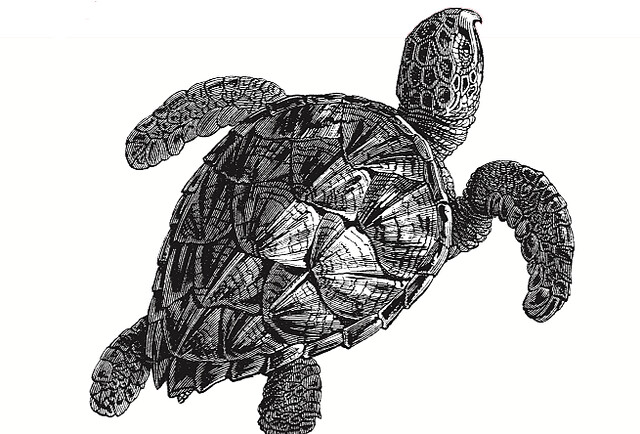The hawksbill sea turtle (Eretmochelys imbricata) is a critically endangered sea turtle belonging to the familyCheloniidae. It is the only extant species in the genus Eretmochelys. The species has a worldwide distribution, withAtlantic and Indo-Pacific subspecies—E. i. imbricata and E. i. bissa, respectively.[2]
The hawksbill’s appearance is similar to that of other marine turtles. It has a generally flattened body shape, a protective carapace, and flipper-like arms, adapted for swimming in the open ocean. E. imbricata is easily distinguished from other sea turtles by its sharp, curving beak with prominent tomium, and the saw-like appearance of its shell margins. Hawksbill shells slightly change colors, depending on water temperature. While this turtle lives part of its life in the open ocean, it spends more time in shallow lagoons and coral reefs.
Human fishing practices threaten E. imbricata populations with extinction. The World Conservation Union classifies the hawksbill as critically endangered.[1] Hawksbill shells were the primary source of tortoiseshell material used for decorative purposes. The Convention on International Trade in Endangered Species outlaws the capture and trade of hawksbill sea turtles and products derived from them.[3]
Adult hawksbill sea turtles have been known to grow up to 1 m (3 ft) in length, weighing around 80 kg (180 lb) on average. The heaviest hawksbill ever captured was measured to be 127 kg (280 lb).[4] The turtle’s shell, orcarapace, has an amber background patterned with an irregular combination of light and dark streaks, with predominantly black and mottled-brown colors radiating to the sides.[5]
Several characteristics of the hawksbill sea turtle distinguish it from other sea turtle species. Its elongated, tapered head ends in a beak-like mouth (from which its common name is derived), and its beak is more sharply pronounced and hooked than others. The hawksbill’s arms have two visible claws on each flipper.
One of the hawksbill’s more easily distinguished characteristics is the pattern of thick scutes that make up its carapace. While its carapace has five central scutes and four pairs of lateral scutes like several members of its family, E. imbricata’s posterior scutes overlap in such a way as to give the rear margin of its carapace a serrated look, similar to the edge of a sawor a steak knife. The turtle’s carapace has been known to reach almost 1 m (3 ft) in length.[6]
Hawksbill sea turtles’ sand tracks are asymmetrical, because they crawl on land with an alternating gait. By contrast, the green sea turtle and theleatherback turtle crawl rather symmetrically.[7][8]
Due to its consumption of venomous cnidarians, hawksbill sea turtle flesh can become toxic.[9]
(From Wikipedia, February 2015)




